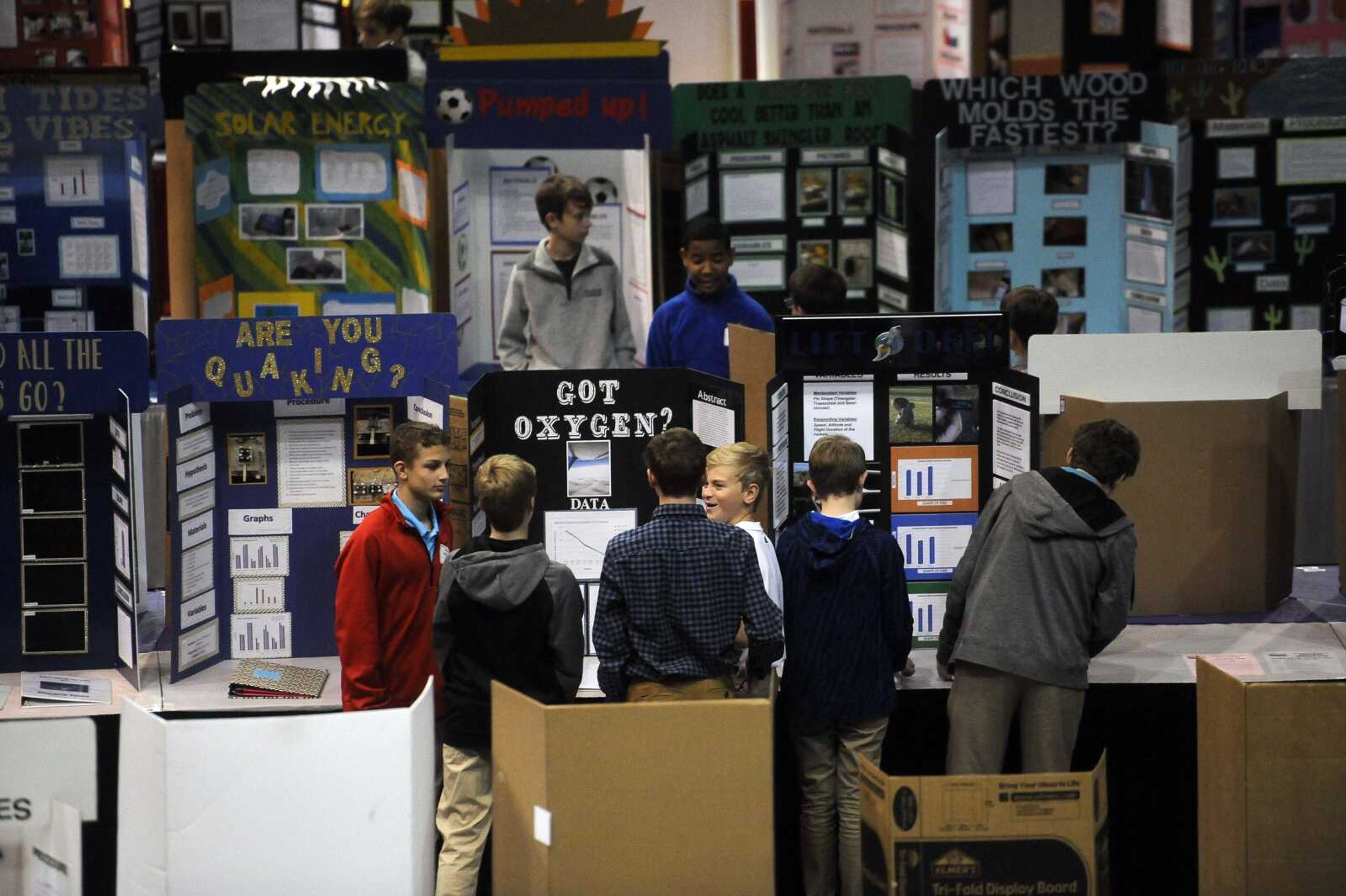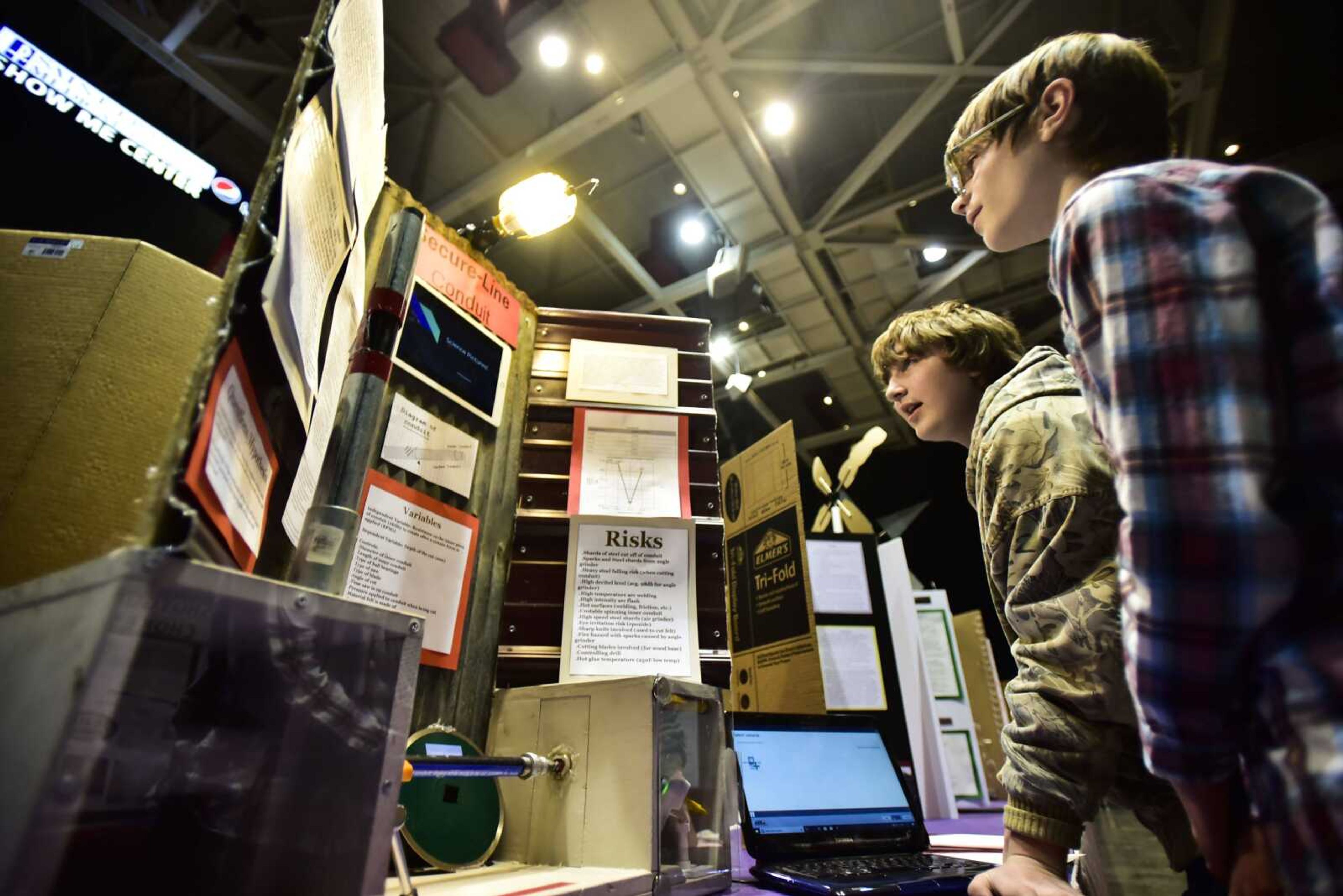Area students compete in 62nd annual science fair
For anyone who�s ever wondered how pH level affects water�s freezing point or the effects of borax on the stretchability of slime, answers abounded in a sea of cardboard tri-fold stands, photos of petri dishes and lists of tools and methodologies at the 62nd annual Southeast Missouri Regional Science Fair...
For anyone who�s ever wondered how pH level affects water�s freezing point or the effects of borax on the stretchability of slime, answers abounded in a sea of cardboard tri-fold stands, photos of petri dishes and lists of tools and methodologies at the 62nd annual Southeast Missouri Regional Science Fair.
More than 650 students contributed to 442 projects at the fair, held Tuesday at Southeast Missouri State University�s Show Me Center, according to a university news release.
The junior division had 380 projects, and the senior division had 62, the release stated.
Dr. Chelsea Grigery, pediatrician with SoutheastHEALTH, and Chris McGowan, retired dean of the college of science, technology and agriculture at Southeast served as the fair�s co-directors.
Grigery said there are a few important points the judges look for when they assess a project.

�How well was it conducted? Was there a good procedure? And how well was it executed?� Grigery said at the event.
Also important are relevance, and whether the project is applicable to real-world situations.
It�s all well and good to see whether brand X paper towels are more absorbent than brand Y, Grigery said, but is that applicable to the real world, and is it relevant?
Grigery pointed to one experiment in the senior division that explored whether certain essential oils had antimicrobial properties against common bacteria including E. coli � that is, would clove oil be as effective at killing E. coli as a traditional antibiotic?
The short answer: no.
Some students did experiments �for fun,� Grigery said, but that wouldn�t be enough to propel them to the next level of competition: the Intel International Science and Engineering Fair (Intel ISEF), to be held in May in Pittsburgh.
Since the sponsorship for the fair more than doubled this year, Grigery said, two projects from the senior division would be chosen to advance and have a chance to win scholarship money � and put an impressive item on their resumes, she said.
Universities and medical schools look at those items, Grigery said.
Her own participation as a student in this very science fair allowed her to participate in the next-level competition and, she said, helped her application to medical school.
�It�s very prestigious,� Grigery said.
She�s also served as a judge and now as co-chairwoman, she said, and those different perspectives have been interesting.
She visited several area schools beginning last fall, and gave presentations on how to craft a good experiment, Grigery added.
Sierra Woodall, 16, a sophomore at Oak Ridge High School, said her experiment pitted phototherapeutic lights against common face cleansers to see which was more effective against facial acne.
Skylar Ponder, 16, and also a sophomore at Oak Ridge, experimented with different types of solar cookers to see which performed better in sunny versus overcast conditions.
Ponder said her results surprised her.
The overcast days were less windy, she said, so the cookers actually performed worse on sunny days, even though the solar cookers use panels covered in tinfoil to reflect and concentrate sunlight for cooking purposes.
Dowsing rods and their effectiveness at finding water or electrical lines was the subject of Carson Gihring�s experiment. Gihring, 12, is a home-schooled seventh-grade student, and said he experimented with metal dowsing rods to see whether he and some friends could determine where water lines were buried.
He held two metal rods loosely at about waist level, he said, to see whether they would cross each other at a water or electrical line, which would indicate the line�s presence.
�I was testing to see if it was accurate,� Gihring said. �It was not.�
He said he accurately determined the placement of lines about 30 percent of the time, which he said wasn�t enough to be considered accurate.
�Nobody really knows how it�s supposed to work,� Gihring said of dowsing, and said he thought electrical currents or magnetism would have something to do with it, but couldn�t make conclusions from the data he collected.
�But it was fun,� Gihring said.
mniederkorn@semissourian.com
(573) 388-3630
Pertinent address:
1333 N. Sprigg St., Cape Girardeau, Mo.
Connect with the Southeast Missourian Newsroom:
For corrections to this story or other insights for the editor, click here. To submit a letter to the editor, click here. To learn about the Southeast Missourian’s AI Policy, click here.









